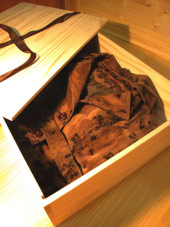
| HOME |
| NERVE |
| REVIEWS |
| ARCHIVE |
| EVENTS |
| LINKS |
| ABOUT US |
| CONTRIBUTORS |
| BACK ISSUES |
| CONTACT US |
 International
06 at Tate Liverpool
International
06 at Tate Liverpool
Tate, Albert Dock (16th
September – 26th November 2006, Tue-Sun 10:00-17:50)
Admission £4(£3)
Reviewed by Hana Leaper
Ironic (or perhaps fitting?) that this exhibition – so aware of the economic factors involved in shaping Liverpool – is the only exhibition involved in the Biennial that charges an entrance fee. There are huge amount of issues surrounding this; the investors in the Biennial and the market forces underpinning the contemporary art infrastructure which are not really addressed anywhere in the official Biennial. It would be naive to think that exhibitions don’t cost or that money can come from nowhere, with no strings attached, or even that art is a reified form, independent of financial considerations. But it is worrying to think that the biennial is receiving funding so that it can be used as a tool to promote a non-socialist vision of the future. The art being selected has, as its agenda, the ‘regeneration of Liverpool’, and fails to contain self-referential material to ask why, and for whom, Liverpool must be regenerated?
The exhibition has been curated with the economic history of Liverpool in mind – the curator’s introduction labels this the ‘rise, fall and recovery’ of Liverpool. Now, bear in mind that this rise was based upon Liverpool’s role as a port and involvement in the slave trade; the decline was based upon the fact that the majority of Liverpool’s citizens did not share in the wealth its rise generated, and that this recovery – as yet moot – is being predicated upon the back of a grand redesign, instigated and implemented by the council, the tourist board and private investors. It’s a regeneration project based solely upon capitalist values – how many jobs will be created (mostly in the service industry), how much revenue will be created (mostly by out of town visitors – not the local people). Is this really something that should be celebrated in art – a medium many still have faith can function as ‘a tool to remediate social inequality’.¹ Or is the social equality art now aims to herald, fundamentally the equality of capitalism?
Consultant Curators Gerado Mosquera and Manray Hsu have commissioned pieces for the International 06 by artists who have the experience to embellish upon their ideas regarding the role of the Biennial in the Liverpool. As this Biennial is almost being regarded as a prequel for the next, the role of art in the ‘redemption’ of Liverpool ‘regeneration’/City of Culture project is implicitly being investigated. ‘The two curators see art channelling energy into and within the city’² – Mosquera has interesting ideas about ‘reverse colonialisation’ whereby he proposes that the historical trade routes originating in Liverpool have continued to facilitate flows of creative energy into the city. Manray has spoken about art as a utensil that delivers ‘archipuncture’ –art imagined/used as medicinal Chinese acupuncture needles ‘in the flesh of the built environment’.
The reactions of the artists to this mandate are rather interesting, very few of them look out to the redesigned Liverpool of the future, preferring instead to focus on sites of memory - how memory pervades and resides in actual fabric and can be recalled by various processes, or the blockage or misdirection of energy that has led to this crisis point in the city’s history.
Jan Yong’s ‘A Better Tomorrow’ (2006) is a DVD, shown within the actual-scale set of a house, which explores a never-ending sequence of beginnings, offering possibilities for the transformation of life through changes in the fabrics in which it is lived. Potential, however is never achieved, as there is no ending in the sequence. The images on the DVD show Liverpool, whereas the narrative is based around Yang’s experience of his parents returning to China from Austria where he grew up and stayed. Yang delivers a clear warning, his parents lived ‘sacrificing today for tomorrow’ – upon the treadmill of utopian promise, to make their children’s lives better than their own, they never took holidays or rested at weekends ‘there was always something they had to do’.
Lee Migwei’s piece ‘Fabric of Memory’ consists of a wooden platform supporting about twenty different sized wooden boxes ties with ribbon, each containing a different hand crafted, material artefact. It aims to show how personal histories can be partially caught within the material weave of objects. Each piece is displayed with writing by the owner explaining the memories it conjures up – a knitted tortoise materialises memories of mother’s friends, birthday treats, carpet colour, family pets and the 70s; a handmade wedding dress marks a deep connection with the maker’s father.
Most poignantly, Esra Erson’s ‘Perfect’ is either a scathing criticism that development work is not going far enough, or, judging by the title, a ray of hope that the soul, the immaterial fabric of Liverpool cannot be altered by regeneration. During this DVD, a makeover is performed upon an elderly, yet active, Liverpool lady – making her vaguely ridiculous but not changing her routine or personality – and conjuring a metaphor regarding the contradictions inherent within visual regeneration. Only the façade is ever altered.
1: Liverpool Biennial International 06, Conference 19-11 Oct, flier
2: Liverpool Tate ‘What’s on guide’, page 4